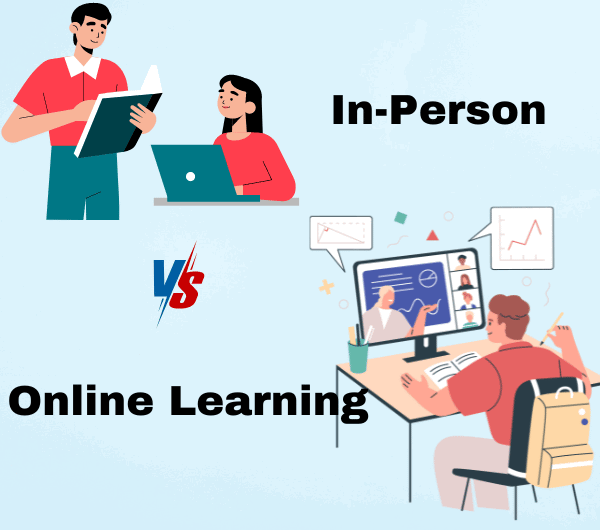At the start of 2020, the world of education came to a standstill. Students could not attend classes in person, which led schools and universities to be more creative in learning. The online learning market got a massive boost in sales and revenues, resulting in them collaborating with esteemed universities and institutions to provide learning opportunities to students and professionals alike.
Online learning has been around since the early 2000s, but it only reached its full potential after COVID-19, and that is when people realized what a boon online learning is.
In this review, we will discuss the advantages and disadvantages of in-person and online learning and how they both compare with the help of global statistics.
In-Person vs. Online Learning Statistics

Quick Summary
- The number of users learning online is supposed to increase to 57 million by 2027(eLearning statistics)
- 69% of students prefer learning thoroughly online, hybrid, or through blended learning options (The Time for Class 2023 survey)
- An online degree is over $10,000 cheaper than a traditional in-person campus degree (Education Data Initiative)
- 52% of graduate students in the U.S. found their online college-level education to provide a better learning experience than their college-level classroom education (Duffin, 2019)
- 77% of academic leaders believe that online education is critical for their long-term strategy (Babson Research Group)
- By 2032, the global eLearning market is expected to be worth $1 trillion. (Global Market Report)
- Since 2020, over 98% of universities have started offering online learning courses and degrees. (eLearning statistics )
What is in-person (traditional) learning?

Most people are familiar with in-person (now known as traditional) learning. You wake up, pack your bag, and go to your school or university. You attend your lectures in a physical classroom with a teacher or professor teaching the class in person. This form of education is still one of the most familiar and common forms of learning. It allows students to interact freely with the instructors and peers, not just to ask doubts but also to discuss new topics. You also get regular assignments and have strict deadlines to adhere to. You receive grades based on your quizzes and assignments frequently, which helps you understand your strengths and weaknesses.
But if you are working full-time or part-time, then this setup would not work for you as you would not have a flexible schedule. The constant deadlines and exams can also be nerve-wracking for some people. And sometimes, the cost of living and tuition is too high for people to afford college. To overcome such shortcomings, online learning came into play.
Pros
- You get to interact with your teachers and peers more openly and frequently.
- Constant evaluation can help you better understand your strengths and weaknesses.
- It helps you develop strong interpersonal relationships with your classmates and allows you to network for the future.
- You get access to campus libraries (they are huge) and research materials.
- You can participate in numerous extra-curricular activities or participate in clubs (chess club, eating club, science club, and more) that are part of the traditional learning system.
Cons
- In-person learning programs are costly, and not everyone can afford them.
- The professors schedule the classes, and you can’t change the schedules if you are busy or need to attend other courses simultaneously.
- Assessments and assignments come with deadlines and add a layer of anxiety to the learning process.
What is online learning?

Online learning, also known as e-learning, is a network of knowledge that allows learners worldwide to learn whenever and however they want. They can also evaluate their progress and test their skills by themselves. These courses use various learning mediums, like visuals. Aural and verbal. Due to this, online learning caters to a wide range of people who want to develop their skills. Online learning is also much more affordable than traditional learning, making it cost-efficient.
The courses available on online learning platforms are often interactive and entertaining, and they come with puzzles and quizzes to keep you engaged. You also get to choose from a massive selection of courses available on these platforms, giving you endless options. Unlike the in-person learning experience, online learning has a flexible schedule, and you can complete your courses while working.
Online learning is in demand, especially after the COVID-19 pandemic. It gave people a unique chance to explore learning while staying at home. Even now, online learning remains an ever-evolving and growing field.
Pros
- Online learning allows for flexibility when deciding your learning schedule. So you can attend classes while also working.
- Online courses are much more affordable than in-person courses, and they also save additional costs (like transport, accommodation, utility, and more)
- You get a greater variety of courses, and you can mix and match. You can study arts and science, or you can study math and creative writing at the same time.
- You get continuous access to videos and learning materials, so in case you need a refresher, you can go through the course material and instructional videos again and again.
- You can interact with students and instructors from all around the world.
Cons
- People who lack self-discipline will have trouble learning online and will feel isolated and lost.
- Online learning is entirely dependent on technology, making it difficult to learn for students who don’t have constant access to the internet.
- Instructors need to be given additional training to help them conduct classes online because it relies a lot on technology, and only some are tech-savvy.
In-person VS Online Learning Statistics in Detail
Understanding the statistics in detail is essential to compare these two learning methods, so let’s get started.
Number of people choosing to learn online
1. The number of online learning platform users is expected to reach 57 million by 2027 (ProsperityofAmerica)
Online learning provides a variety of courses at an affordable price, making it a more convenient option for people all around the world
2. More than 30% of American students have taken at least one online course (Taylor & Francis Online)
More and more students in America enroll in online courses either out of curiosity or for convenience. Studies have shown more than half of these students also attend in-person classes.
3. More than 200 million learners signed up for at least one massive open online course in 2023 (The Report)
Online learning platforms have been active since the late 2000s, but 2023 saw a remarkable jump in the number of students enrolling for at least one of the classes online.
4. Women prefer learning online more than men (Statista)
Out of 100, 49 undergraduates were men, while 51 were women. Of the graduate students, 52 were women, while 48 were men.
5. The number of undergraduate students who took one or more online courses increased by 97% in 2020 (National Centre for Education Statistics)
These people took some online classes but didn’t study entirely online and attended in-person courses.
Effectiveness of online learning
1. 70% of students agree that online classes are better than traditional classroom settings (University of the Potomac)
Research done by the University of the Potomac found that most students like the flexibility and convenience provided by online learning.
2. 77% of academic leaders believe that online education is critical for their long-term strategy (Babson Survey Research Group)
Most academic leaders believe online education is critical for their long-term strategy, and 69% of higher education institutions offer online learning.
3. In 2020, the number of virtual classroom sessions increased significantly. More than 75% of faculty members reported using video conferencing tools to conduct online classes (Inside Higher Ed)
Due to the COVID-19 pandemic, most of the learning shifted online, and according to a report by Inside Higher Ed, most teachers chose to take classes online.
4. Study shows that e-learning helps students retain between 25% and 60% more information (eLearning Industry)
The lack of deadlines and pressure and the overall ease of self-paced learning make it easier for students to retain information quickly and effectively.
5. 8 in 10 students claim that digital technology helps them improve their grades (TechJury)
Learning online helps students retain information while decreasing the learning time, making the process more efficient and improving their grades and overall performance.
Growth of online learning revenue (and more)
1. By the year 2032, the global eLearning market is expected to be worth $1 trillion (Global Market Insights)
Online learning has made itself valuable in the last decade, and the global market has been rapidly growing, with more and more people choosing to study online, generating massive revenues for many providers.
2. Online learning will have a 9.1% compound annual growth rate by 2026 (Syngene Research)
In the last five years, the online learning industry has grown by over 7% and is expected to grow more by 2026.
3. The online learning sector had grown to be a $240 billion industry by 2022 (Email Vendor Selection)
That’s up from $150 billion in 2012, over $100 billion increase in less than a decade.
4. Online learning has grown 900%+ since its launch (Oxford University)
Since the beginning of online learning, the worldwide has grown over 900%. Online learning is one of the most rapidly growing industries in the world.
5. The number of online learning platform users is expected to reach 57 million by 2027 (ProsperityforAmerica)
As mentioned earlier, online learning provides a variety of courses at an affordable price, making it a more convenient option for people worldwide.
Preference of people
1. Most students, when asked, say that online learning is better than traditional learning (University of the Potomac)
More than 70% of students choose to learn online due to its convenience and affordability.
2. Over 90% of students who have taken online courses are likely to recommend the same to their peers and colleagues. (Best Colleges)
3. 36% say completing an online course is more accessible than learning in a classroom (Oxford University)
More than one-third of students claim that online learning is a more effortless and better learning experience than traditional learning.
4. An online degree is over $10,000 cheaper than a traditional in-person campus degree (Education Data Initiative)
Online education is much cheaper than college tuition and other expenses, making it an ideal choice for people who don’t want to compromise with their education but also want to stick to a budget.
5. 44% of online students reported that their virtual classroom sessions were as engaging as traditional ones. (Learning House)
According to a survey conducted by the Learning House, students reported that online classes were much more fun and engaging than in-person classes.
Online learning experience for business
1. 3 out of 4 companies provide learning opportunities for their employees (Think Impact)
Employee upskilling has become a big issue for major companies and organizations, and they all prefer using online learning platforms.
2. Online learning requires 60% less employee time than in-person classes (Brandon Hall)
Because of the flexibility provided by online learning, employees can upskill without compromising their productivity.
3. Corporate participants learn almost 5x with online courses compared to traditional learning (SHIFT)
Online learning is a cost and time-effective way to train employees.
4. Companies offering online courses see an increase in revenue (TechJury)
By introducing online classes, companies have seen over 24% increase in profits.
5. Online learning can help employees perform better by at least 15% (American Heart Association)
A self-paced learning environment encourages employees to invest more time and effort into learning new skills and eventually improve their performance.
Conclusion
These are all the major statistics that help you understand the differences between in-person and online learning. You also have a list of pros and cons to help you decide what suits your needs the best. Which type of education is ideal for you mostly depends on your requirements and preferences. It also depends on your situation, location, age, and gender.
But it would help if you accepted that online learning is the future, and you need to explore it more to understand what it offers.
Both learning modes have advantages and disadvantages, but online learning provides flexibility and is much more affordable than in-person learning.
